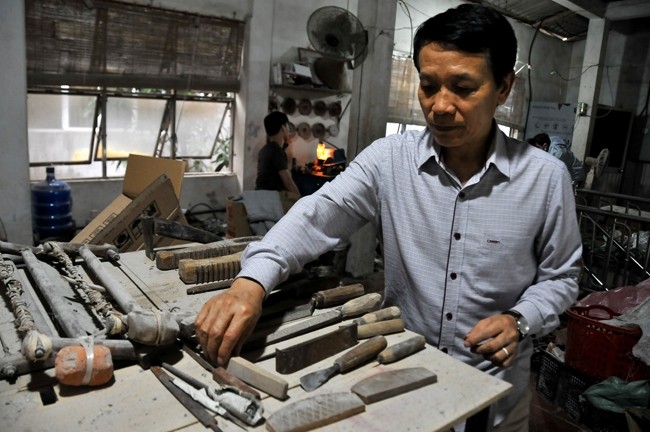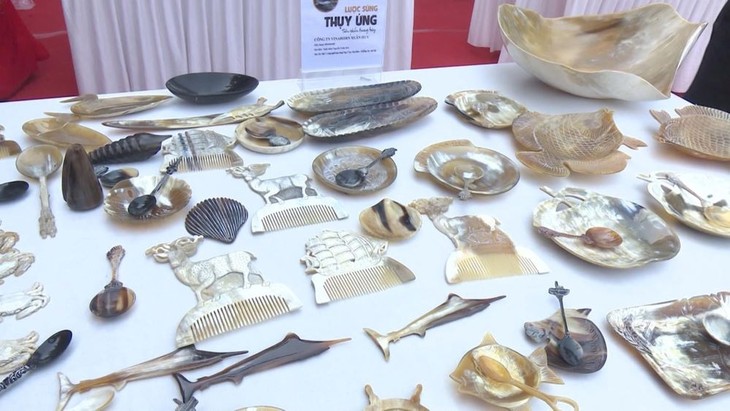(VOVWORLD) -Thuy Ung village in Thuong Tin district, 30 kilometers south of Hanoi, has been making combs from buffalo and cow horns for 400 years. Since the mid-16th century, the craft has been passed down from generation to generation of villagers.
 The craft to make combs from buffalo and cow horns has been passed down from generation to generation in Thuy Ung village. (Photo: dangcongsan.vn) The craft to make combs from buffalo and cow horns has been passed down from generation to generation in Thuy Ung village. (Photo: dangcongsan.vn) |
Making horn combs involves multiple steps – boiling and pressing the horns into molds, cutting the teeth, and then brushing and polishing the combs. The materials are mainly buffalo horns and hooves purchased from northern mountain provinces. When the domestic supply of horns is insufficient, Thuy Ung villagers have to import material from Laos, Thailand, Cambodia, and Africa.
Combs made from horn are more valuable than those made from hooves. Buffalo horns from different places have different colors. Vietnamese buffalo horns are black, while African buffalo horns are ivory.
Old, strong buffaloes have the best horns. They’re thicker, shinier, and have beautiful veins, says Nguyen Thanh Trung, a Thuy Ung craftsman. “Good buffalo and cow horns must be thick and wide. White buffalo horn is the most valuable because it has the highest quality and is the scarcest,” said Trung.
To make a comb, first you need to saw off both ends of the horn leaving only the body, which should be 4 to 5 millimeters thick. Then, this part is cut lengthwise into two pieces. These pieces are cut into short or long pieces depending on the craftsman's intention.
A thin, sharp saw blade is needed to avoid scratching the horn. Before it’s shaped, the raw horn needs to be softened. In the past, the villagers covered the horn with hot ash, but now it’s boiled in oil at a high temperature. At 200 degrees C, it takes 4 to 5 minutes for the raw horn to expand and soften. Then it must be immediately rinsed with cold water.
According to Trung, “Oil boils at a higher temperature than water. It’s hot enough to soften the horn without affecting the horn’s quality.”
After being softened, the horn is put into a hydraulic press and rolled until it’s thin and flat. Young buffalo horn can be easily carved. The horn of an old buffalo, on the other hand, is more easily broken after pressing.
The shape of the comb is marked with a pencil on the flat piece of horn. According to Thuy Ung craftsmen, a comb will break easily if it is aligned with the vein. On the other hand, carving at an angle to the vein will make the comb more durable.
The price of a horn comb is determined more by its production cost than by the cost of the raw material. After being rolled and shaped, the horn comb is soaked in water for about an hour and smoothed on both sides. Six different types of sandpaper are used to smooth the comb.
Nguyen Van Thai of Thuy Ung village said, “You have to keep sanding the comb until it’s flat, then cut the teeth. After cutting the teeth, you need to smooth it again.”
 Horn combs branded by Thuy Ung village (Photo: hanoimoi.vn) Horn combs branded by Thuy Ung village (Photo: hanoimoi.vn) |
Depending on the type of comb, the craftsman will use a different type of saw to cut the teeth. Creating the teeth is the most difficult step and requires the most skill. Not everyone in the workshop can perform this step.
The teeth near the ends of the comb are cut more shallow. The closer to the middle, the deeper the saw blade cuts. If the distance between the teeth is uneven, the comb is considered damaged and cannot be repaired.
As a Thuy Ung craftsman says, “If your two hands push the saw in a balanced manner, the comb teeth will be even. There won't be any big or small teeth. If your hands are unbalanced, the teeth will be irregular, one end bigger and the other smaller.”
After the teeth are cut, the comb undergoes two dry rubbings and two wet rubbings. Dry or wet, the rubbing must be by hand. This step creates the comb’s flatness and shine, said Trung, adding that the comb must be shiny and free of blemishes.
“Horns often have many holes and small blemishes but high-quality products eliminate these blemishes. The most valuable color is clear white, slightly yellow,” Trung noted.
In the past, Thuy Ung only produced combs with simple shapes. Now there are many types of combs, some with elaborate carvings. Thuy Ung horn combs are sold in South Korea, Japan, and China, where high-quality handicraft products are prized.